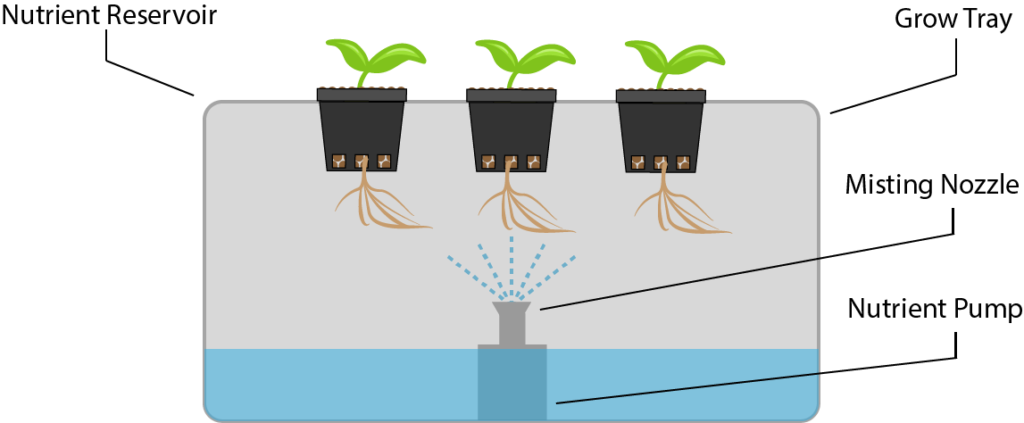Unlike any of the other hydroponics systems, aeroponics is a complete open air system where nutrients are provided through a fine mist directed at the roots. This system can be confined to a small chamber or scaled up into a warehouse.
The root systems of the individual plants are held by net baskets which can be inserted to the top of chamber or suspended from a ceiling. Growing media can be used to add extra support and weight balance to over plant. Depending on what height restrictions you are working with, you can grow large vining plants with trellises or small compact plants.

Also termed “soakaponics”, low-pressure aeroponic systems are the most popular among aeroponic gardeners. Most hydroponic stores have a low-pressure system in stock. The low pressure comes from the power behind the misters, so this version does not require a high tech water pump. One thing to note is that adding more sprinkler will drop the pressure further creating larger droplets of nutrient solution hitting the root system like in the Nutrient Film Technique.
Therefore, the best sprinkler heads are those that the spray overlaps and completely covers the entire root zone. As the root mass gets big, it is often hard for the spray from the sprinkler heads to penetrate the thick root mass. Spraying the roots from above the root mass or near the top of it will allow the water to trickle down through the root mass.
While the low-pressure systems are the most common, high-pressure aeroponic systems are the “true aeroponic” systems. That is because it takes the higher pressure push the water into a fine mist with a small water droplet size. This fine mist allows the roots to get a lot more oxygen than in low-pressure systems. However, it is more complicated and expensive to build a high-pressure aeroponic system.
The one required essential for long term space travel is the ability to grow food. Flights to the moon allow for the smallest amount of food possible to make room for other cargo. Aeroponically technology changes that. As you read this, aborad the International Space Station is the aeroponic chamber aptly named Veggie. It currently grows different varieties of lettuces for the cosmonauts aboard the space station. This technology also is source of fresh oxygen and drinking water for those looking to inhabit a planet far, far away.

“What exactly is Genesis? Well, put simply, Genesis is life from lifelessness.” – Carol Marcus, 2284 (Star Trek II: The Wrath of Khan)
The first commercially available aeroponic apparatus manufactured and marketed was in 1983. It was known then as the Genesis Machine – taken from the movie Star Trek II: The Wrath of Khan. The Genesis Device in the movie was designed to correct the consequences of an agricultural revolution, such as overpopulation and food deserts. It was a projectile missile that when detonated would create an atomosphere condusive to life.
The Genesis Machine took on the revolution of air based agriculture. It was very simple in that it is aeroponic chamber connected to a water faucte and controlled by a microchip.
Aeroponics made another appearance in the Star Trek universe on the Space Ship Voyager captained by Cathryn Janeway. Voyager gets lost in a part of space very far from their home and picks up a band of misfit aliens along the way. Kes was one of those aliens who recognized a need for vegetation from her home planet that the on ship replicator could not produce. Kes creates the Airponics bay to fill that need.

